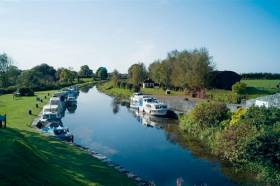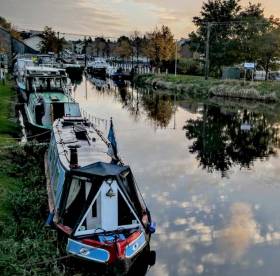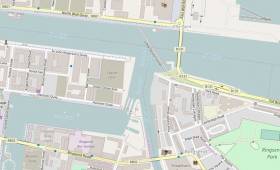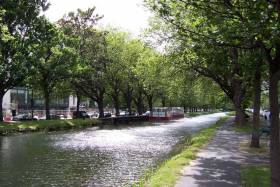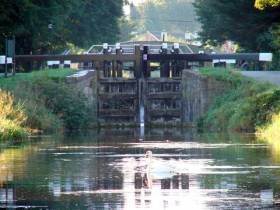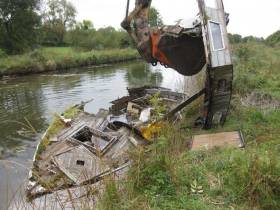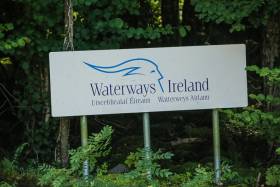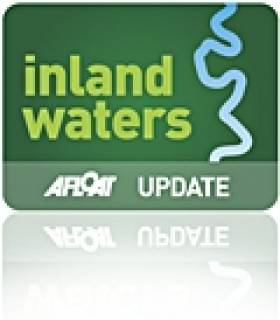Displaying items by tag: Grand Canal
No Further Passage In 2017 On Grand & Royal Canals
#InlandWaters - Waterways Ireland wishes confirms that no further boat movements will be organised into or out from Dublin east of Lock 12 on the Grand and Royal Canals until the 2018 season.
The Grand Canal will shortly be closed for works in the Bluebell area in Dublin, and water levels will be reduced for the winter season.
Waterways Ireland apologies for any inconvenience this may cause its customers and thanks their customers for their understanding in this matter.
Celebrating the Grand Re-Opening: 30 Years of the Naas Canal
The Inland Waterways Association of Ireland (IWAI) Kildare will return again to Naas Harbour to celebrate the Naas Canal Festival which runs from Friday October 27th to Monday October 30th. This year’s Festival is a very special event as 2017 marks 30 years since the Naas Line of the Grand Canal was re-opened to boat traffic. In the early 1980s, a fledgling IWAI Kildare, supported by IWAI Dublin, highlighted the potential for tourism development of the Grand Canal in Naas. 30 years on and a large fleet of boats is expected to attend the Festival in Naas Harbour. On Friday 27th and Saturday 28th the travelling boats will be assisted through the locks by staff from Waterways Ireland, IWAI Kildare volunteers and members of the 23rd Kildare – Sallins – scouts, who are eager to put their lock operation training into practice. If you have never seen a lock being used or you have never seen a boat cruise the canal, this October weekend will not disappoint.
As well as the flotilla of vessels old and new, there will be a number of public events in the lead up to and during the Festival. A Waterways Exhibition will run in Naas Library from Monday October 23rd to Friday 27th featuring material from IWAI, the Heritage Boat Association and Waterways Ireland. There will be a variety of activities taking place on Sunday afternoon, October 29th, from 1pm to 5pm, including music from The Water Gypsies, Waterways Information Talks, an Exhibition by Sean Curran Art, boat trips on the canal by bargetrip.ie, the launch of a new children’s book by author Emma-Jane Leeson who will host readings from her book on a Barge. Of course, the boats themselves will also be on display and the boat owners will be on hand waiting to answer your questions or even give you a tour; don’t be shy about approaching them.
In the spirit of the founders of the IWAI, who established the Association in 1954 to campaign against the installation of fixed-span bridges across the River Shannon, IWAI Kildare will use the Naas Canal Festival to continue to showcase the leisure potential and historical significance of the Grand Canal in this area.
The Inland Waterways Association of Ireland (IWAI) is a voluntary body representing over two thousand enthusiasts, with 23 branches across the island of Ireland.
The Inland Waterways Association of Ireland (IWAI) is an energetic, fun, voluntary organisation with members from all corners of the Island of Ireland, all sharing a keen and passionate enthusiasm for the waterways of Ireland.
The IWAI advocates the navigation, use, maintenance, protection, restoration and improvement of the inland waterways of Ireland. It was formed in 1954 to promote the development, use and maintenance of Ireland's navigable rivers and canals.
IWAI Kildare was established in 1984. In the early years IWAI Kildare was assisted by IWAI Dublin to restore and enable the re-opening to navigation of the Naas Line of the Grand Canal main line. Currently, IWAI Kildare aims to promote the use of the waterways of Co. Kildare by running rallies throughout the county.
IWAI Kildare is actively campaigning to re-open the Corbally Line of the Grand Canal from Naas Harbour to Corbally Harbour. This stretch of waterway is in good condition but passage for boats is blocked by a number of culverted crossings, including the road from Naas to Newhall which crosses the canal near Jigginstown.
Funding For Grand Canal Basin Bridge In New Infrastructure Plan
#DublinPort - A new public transport bridge for Dublin’s south quays will receive more than €15 million under a new State infrastructure scheme to encourage new housing.
As TheJournal.ie reports, the proposed Dodder Bridge would span between Britain Quay and York Road at the confluence of the River Dodder and the Grand Canal — creating a more direct link between the city and the Poolbeg Peninsula, which has been designated as a Strategic Development Zone.
The move has not been welcomed by the boating community, however, as WM Nixon noted on Afloat.ie last month how such a bridge would cut off access to the Grand Canal Basin for all but the lowest clearance ‘canal boats’.
The news also comes after the Dublin Port Masterplan’s own proposals for a new north-south bridge immediately east of the Tom Clarke East Link Bridge at York Road, as previously reported on Afloat.ie.
TheJournal.ie has more on the story HERE.
Body Recovered From Grand Canal In Search For Missing Man
#GrandCanal - BreakingNews.ie reports on the recovery of a body from the Grand Canal in Dublin yesterday (Sunday 18 December) in the search for a missing man.
The body was recovered by the Garda Water Unit at lunchtime yesterday near Harcourt Terrace in the city centre during the search for 25-year-old Mehdi Hasan, who was last seen in on Leeson Street around 4am on Friday morning (16 December).
Naas Grand Canal Festival This Bank Holiday Weekend
The inland waterways of Co Kildare comes to life this coming October Bank Holiday weekend. Inland Waterways Association of Ireland (IWAI) Kildare will host it’s now annual Naas Canal Festival from Friday October 28th to Monday 31st. A large fleet of boats is expected to assemble in Sallins harbour on Friday followed by a parade along the Grand Canal, up through the flight of five locks into Naas harbour.
The parade will leave Sallins at 11am and all boats should be in Naas harbour by 5pm. In the spirit of the founders of the IWAI, who established the Association in 1954 to campaign against the installation of fixed span bridges across the River Shannon, IWAI Kildare will use the Naas Canal Festival to showcase the leisure potential of the Grand Canal in this area.
Whether your passion involves travelling through locks by boat, paddling a canoe, walking or cycling for health, well being and enjoyment or waiting patiently for a bite on your fishing line, IWAI Kildare invites you to immerse yourself in the amazing engineering achievement that is the Grand Canal.
IWAI Kildare was established in 1984. In the early years IWAI Kildare was assisted by IWAI Dublin to restore and enable the re opening to navigation of the Naas branch of the Grand Canal main line.
Currently, IWAI Kildare aims to promote the use of the waterways of Co. Kildare by running rallies all over the county.
IWAI Kildare is actively campaigning to re open the Corbally branch of the Grand Canal from Naas harbour to Corbally harbour. This stretch of waterway is in good condition but passage for boats is blocked by a number of culverted crossings, including the road from Naas to Newhall which crosses the canal near Jigginstown.
Sunken Craft Removed From the Barrow Line of the Grand Canal
The salvage and disposal of a number of sunk and abandoned vessels from the Barrow Line of the Grand Canal at Lowtown took place on 12-13 October 2016 by Waterways Ireland.
As part of the canals clean up a number of sunken and abandoned, non permitted, vessels were targeted for removal and disposal from the canals. Every effort was made to trace owners of the vessels via the permit database, Shannon Registration number or local knowledge. No owners or interested parties were found.
Upon inspection of all vessels by the Assistant Inspector of Navigation, it was determined that none of the vessels were salvageable and were beyond economic repair. Consequently it was decided to remove and dispose of the wrecks. A company was contracted to undertake the work.
The first vessel, a steel hulk has been sunk on the Eastern bank of the Barrow Line for approximately 5 years. Accumulated debris and rubbish hindered the pump out but eventually the vessel was floated. The vessel was recovered onto the canal bank after 7 hours of work. As initial cuts with cutting equipment were made, Waterways Ireland received a request from Heritage Boat Association to pause the removal of the vessel as it potentially had heritage value. No further cutting was done and the hulk has been left on the canal bank, overturned to prevent further ingress of water, while the HBA's interest is followed up.
Removal of the other vessels went ahead as planned. Most vessels broke up as they were being towed to the Western bank for disposal. A diver in the water recovered all floating debris and heavy materials were recovered with the assistance of a digger bucket.
One vessel was pumped out and returned to its owner who was identified after a number of phone calls on 13th October.
Vessel removal was completed on 13th October with contractor returning on site on 14th October to "dress" the bank and remove any remaining debris.
Waterways Ireland requests owners of boats on the Grand Canal, Royal Canal and Barrow Navigation to ensure they have a valid permit and that the Inspector of Navigation has been provided with up to date contact details.
Canal Passages Into & Out of Dublin Suspended Due to Anti–Social Behaviour
Waterways Ireland is advising masters and owners of vessels that passages into and out of Dublin are presently suspended in light of recent anti-social behaviour which has given rise to safety concerns for boaters and staff alike.
Inspector of Navigation C.J.Lawn says the 'present arrangements are being reviewed' to ensure that there is adequate security to ensure safety for all concerned in order that passages can be resumed at the earliest opportunity.
Gardai Restrict Boat Movement on the Grand & Royal Canals
Waterways Ireland has been requested by An Garda to limit boat movements on the Royal and Grand Canals in the Kildare area throughout this week from 25 to 31 January, during the course of an on-going investigation, particularly from the Dublin county boundary to Sallins and Maynooth respectively on the two canals.
Waterways Ireland asks that owners and masters abide by this request, and plan boat movements accordingly.
The Grand Canal & The South Pole
Athy is not really a maritime town in the coastal sense of that description. Its marine connection is, essentially, the Grand Canal on Ireland's inland waterways linking Dublin to Limerick and which was extended to Athy in 1791 when it took 13 hours to get from there to the capital by boat. Canal passenger services began at the early hour of 5 a.m. on what was considered to be an expensive service.
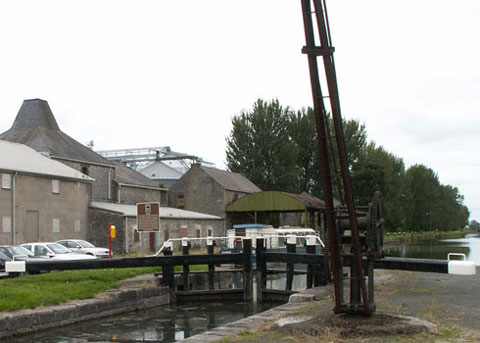 Athy on the Grand Canal
Athy on the Grand Canal
A Quaker writer, Mary Leadbeater from Ballitore near Athy, described passengers as ‘half gentry’ and noted that “there was card playing.”
There was worse than that in December of 1792 when five men, four women and two children died in an accident on a boat from Athy, blamed on “upwards of 150 people, many of them intoxicated, who forced themselves onto the boat in spite of repeated remonstrances from the Captain who in vain, told them the boat was overloaded and must sink if many of them did not withdraw. At length from their numbers and turbulence the boat was overset, near the eight lock,” reported The Freeman’s Journal.
Commercial trade on the Canal boosted Athy’s fortunes until the railway line from Dublin to Carlow forced the closure of business in 1846.
The Canal had been closed for 32 years when a child was born close to the village of Kilkea, between Castledermot and Athy, in the south of County Kildare, who would become a legend in Polar Exploration and lead to the town’s Heritage Centre-Museum having the only permanent exhibition anywhere devoted to that child who became the legendary explorer, Ernest Shackleton. Highlights include an original sledge and harness from his Antarctic expeditions, a 15-foot model of his ship, Endurance, an exhibition of Shackleton family photographs and an audio visual display featuring Frank Hurley’s original film footage of the Endurance expedition.
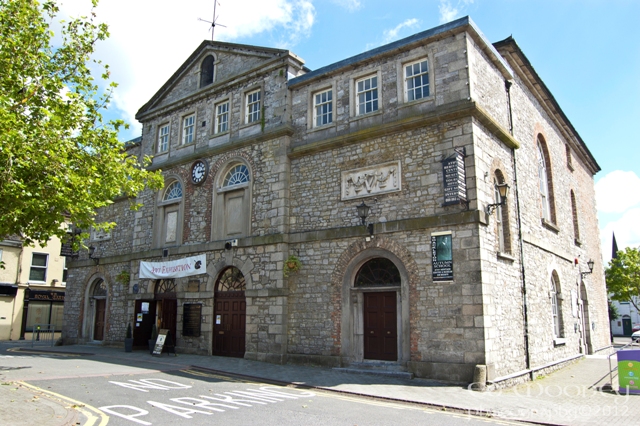 Athy museum
Athy museum
The Shackleton Autumn School was established in Athy to commemorate the explorer. It provides a forum for discussion about Polar Exploration, about Shackleton and the presentation of relevant artistic work.
My main story in the current edition of my radio programme, THIS ISLAND NATION, is about Athy’s connection with Shackleton and the restoration of the cabin in which he died of a heart attack in the Antarctic on January 5, 1922 at Grytviken in South Georgia. The cabin is being restored at Letterfrack in Connemara. A Corkman, Eugene Furlong, initiated a project which is leading to its display at the Shackleton Museum in Athy. He located it during a visit to Norway. The restoration is being carried out at Conservation Letterfrack, where Janet O’Toole describes the work they will do. Joe O’Farrell of the Athy Museum Committee describes how they got the cabin back to Ireland.
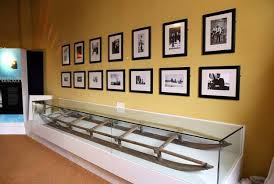 Shackleton sledge
Shackleton sledge
It’s a story of determination and achievement and how an Irish town has led the way in honouring the memory of Shackleton.
Also on the programme you will hear a somewhat remarkable sea shanty, about the Keeper of the Eddystone Lighthouse, his Mermaid friend and the family they conceived, believe it or not!
In serious vein, the RNLI and Irish Water Safety deliver the message of safety at sea, which should never be forgotten.
As always, there is plenty to report about the maritime sphere and I hope you enjoy this fortnightly programme.
Fair sailing
Talk On The Grand Canal In Offaly 1794-1804
#InlandWaters - Tullamore's Offaly History Centre will host a talk on Monday 23 March on the history of the Grand Canal in Offaly from 1794 to 1804.
Presented by James Scully, the talk will be based on various contemporary sources, most notably the invaluable records within the Grand Canal minute books.


























